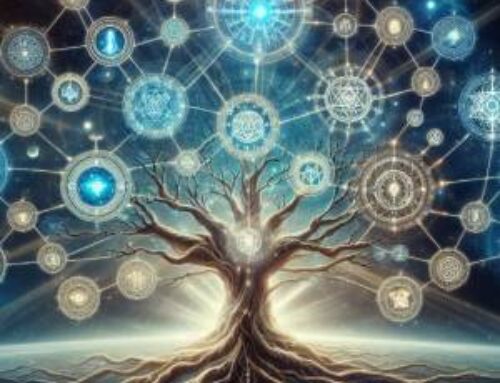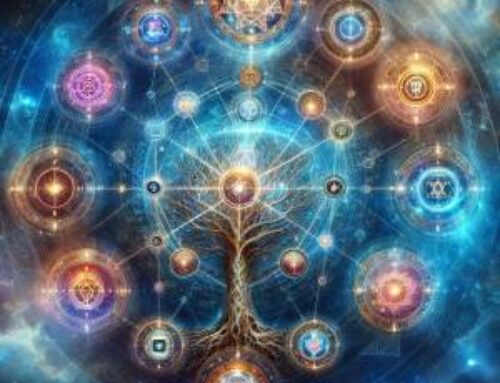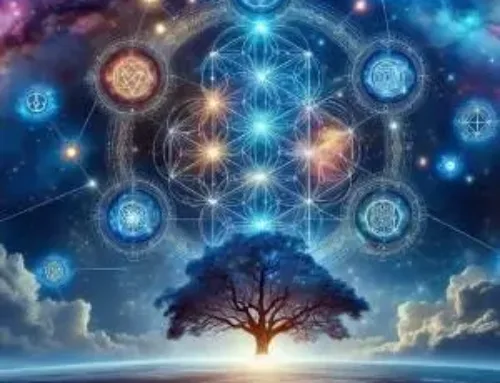Contents
- 1 Introduction to “Kabbalists do it better”
- 2 The Tree of Life; A Blueprint, for Existence
- 3 Understanding the Structure and Energy Flow within the Tree
- 4 Practical Implementations of the Tree of Life
- 5 Exploring Kabbalistic Meditation
- 6 The Influence on Personal Development
- 7 FAQ- Kabbalists
- 7.1 1. What exactly is Kabbalah?
- 7.2 2. Why does the Tree of Life hold significance in teachings?
- 7.3 3. How do Kabbalistic meditations differ from meditation practices?
- 7.4 4. What purpose do rituals serve in Kabbalah?
- 7.5 5. Is it possible for anyone to learn about Kabbalah?
- 7.6 6. What advantages might I experience by becoming a member of the Hermetic Academy?
- 8 References
Introduction to “Kabbalists do it better”
In the realm of studies few traditions capture the imagination and touch the heart like Kabbalah. With its roots, in wisdom and veiled in secrecy Kabbalah offers insights into existence the universes structure and the unseen forces that shape our lives. Throughout history Kabbalists have been revered as guardians of these mysteries exploring the paths of the Tree of Life and delving into the ten divine emanations – to uncover truths beyond our physical reality. The saying “Kabbalists excel” reflects this traditions enduring charm implying that those immersed in Kabbalah gain abilities to enhance their understanding and perception of reality.

Kabbalah isn’t a concept; it serves as a practical manual for spiritual enlightenment and personal development. Despite its complexity often veiled in layers its teachings offer guidance for anyone embarking on a journey of self discovery. By studying and practicing Kabbalah individuals can establish a connection with the divine opportunities, for significant personal growth.
The teachings and practices of Kabbalists aim to help individuals align themselves with the order providing tools to navigate lifes challenges and discover balance in todays world. This article intends to explore why Kabbalists are perceived as excelling by examining aspects of teachings and practices. We will discuss the Tree of Lifes structure the significance of its ten sephiroth and how Kabbalistic meditation and rituals can bring about transformation (1). By delving into these components we hope to offer an insight into what makes Kabbalah a potent spiritual path.
The Tree of Life; A Blueprint, for Existence
In thought the Tree of Life serves as a symbol representing both the universes grand scheme and an individuals soul. Comprised of ten spheres each embodying a aspect this diagram is interconnected by 22 paths symbolizing various spiritual states through Hebrew alphabet letters. Understanding this framework is crucial for grasping the wisdom within Kabbalah.
More than a representation the Tree of Life signifies an evolving consciousness process. Each sphere, on the tree corresponds to aspects of experiences and spiritual growth.
The interconnected pathways demonstrate how these elements interconnect and impact each other forming a depiction of existence. For those following teachings the Tree of Life acts as both a tool, for meditation and a roadmap for development offering insights into the essence of reality and oneself.
Understanding the Structure and Energy Flow within the Tree
The right and left pillars of the Tree of Life symbolize the female energies correspondingly. These are brought into harmony by the pillar, which maintains equilibrium between the forces at play. This threefold arrangement emphasizes the significance of equilibrium and synthesis in traditions. The male pillar embodies. Generosity, while the female pillar represents openness and receptivity. The center pillar reconciles these opposites nurturing unity and peace.
Practical Implementations of the Tree of Life
In contexts the Tree of Life provides a structure for growth. By reflecting on its spheres and pathways through meditation practitioners can gain insights into their being as well, as universal operations. This introspective practice involves envisioning the Trees arrangement and reflecting on each spheres characteristics in an attempt to internalize them. Through this transformative journey individuals strive to align themselves with harmony promoting progression and enlightenment.
Exploring Kabbalistic Meditation
Exploring the Divine
Engaging, in meditation is an aspect of the tradition providing a way to commune with the divine and reach elevated levels of awareness. Unlike meditation practices Kabbalistic meditation follows a structured approach involving deep reflection on specific symbols and ideas. This method aims to awaken capacities and enhance ones insight into the concealed realms of existence.
Methods and Customs
A key technique in meditation involves using sacred names and phrases often rooted in the Hebrew language believed by Kabbalists to possess inherent spiritual potency. Reciting or visualizing these names can create a vibration that links the practitioner with planes of consciousness. Moreover meditating on the Tree of Life itself concentrating on spheres and pathways can lead to spiritual revelations and encounters.
The Significance of Intent and Imagery
Intent plays a role in meditation. Practitioners are advised to establish intentions before commencing their practice whether seeking healing, enlightenment or a deeper communion with the divine. Visualization is another element as it aids in internalizing concepts rendering them experientially tangible. By envisioning the spheres and their characteristics Kabbalists can bridge the gap, between physicality and spirituality rendering that which is unseen reachable.
The Transformative Influence of Kabbalistic Ceremonies
Rituals play a role, in traditions acting as a link between the ordinary and the divine. These ceremonies often involve rituals that include actions, sacred artifacts and specific chants. By engaging in rituals Kabbalists strive to summon energies and harmonize themselves with the order fostering individual and communal growth.
Aspects of Kabbalistic Ceremonies
Kabbalistic rituals are steeped in symbolism. Carefully crafted to mirror the layout of the Tree of Life. They may encompass activities like lighting candles using incense and reciting prayers or holy texts. Each element of the ceremony is meant to resonate with spheres and pathways creating an sacred environment. The objective is to transcend reality and enter a state of consciousness where profound spiritual insights can be uncovered (2).
The Influence on Personal Development
Participating in ceremonies can deeply impact development. These practices go beyond performance; they are experiences intended to shift the practitioners mindset and foster a deeper bond with the divine. Through rituals Kabbalists aim to purify their intentions align their behaviors with values and nurture a sense of oneness, with the universe.
Engaging in these rituals regularly can bring about changes, in how we see things and behave encouraging an enlightened and balanced way of life. In the end Kabbalists excel not due to any superiority. Because they immerse themselves in a profound tradition that offers unparalleled insights into existence and the self. By studying and practicing Kabbalah they acquire tools for growth, spiritual development and uncovering deeper truths. The Tree of Life serves as a framework for comprehending the universe while Kabbalistic meditation and rituals provide ways to connect with the divine.
For those to exploring the mysteries of Kabbalah the benefits are vast. This tradition presents a journey towards enlightenment and a stronger bond with the divine. Whether through meditation, rituals or delving into texts Kabbalists nurture a perspective that helps them navigate lifes obstacles, with grace and wisdom. In a world often consumed by matters the depth and richness of practices demonstrate the enduring influence of ancient wisdom. By embracing these teachings anyone can begin unlocking their potential and uncovering realities beyond what meets the eye.
Join the Hermetic Academy to discover the mysteries of Kabbalah and enhance your journey, under expert guidance.
FAQ- Kabbalists
1. What exactly is Kabbalah?
A: Kabbalah stands as a tradition aimed at unraveling the essence of the universe and the human spirit. It offers an approach to comprehending the realm and equips individuals with practical tools for spiritual growth and self transformation.
2. Why does the Tree of Life hold significance in teachings?
A: The Tree of Life represents a symbol in philosophy symbolizing both the grandeur of the cosmos and the intricacies of ones inner self. It acts as a roadmap for progress guiding individuals through meditation practices and rituals.
3. How do Kabbalistic meditations differ from meditation practices?
A: Unlike forms of meditation Kabbalistic meditations are meticulously organized, focusing on specific symbols, names and concepts. These practices aim to awaken potentials and deepen ones comprehension of realities.
4. What purpose do rituals serve in Kabbalah?
A: Rituals within Kabbalah bridge existence with realms, by incorporating symbolic actions, sacred artifacts and precise invocations to connect with divine energies and harmonize with cosmic principles. These rituals facilitate growth and communal transformation.
5. Is it possible for anyone to learn about Kabbalah?
A: Although Kabbalah used to be a practice its teachings are now more open, to the public. However delving into it requires commitment and a readiness to explore its profound ideas.
6. What advantages might I experience by becoming a member of the Hermetic Academy?
A: By enrolling in the Hermetic Academy you’ll have the opportunity to access teachings receive guidance, from seasoned instructors and be part of a supportive community focused on spiritual development and enlightenment.
References
(1) Rubenstein, E. (2020). The Tree of Life: The Kabbalah of Immortality. Hermetic World, Paphos.
(2) Rubenstein, E. (2023). Alchemy: Secrets of Consciousness Transformation. Hermetic World, Paphos.





